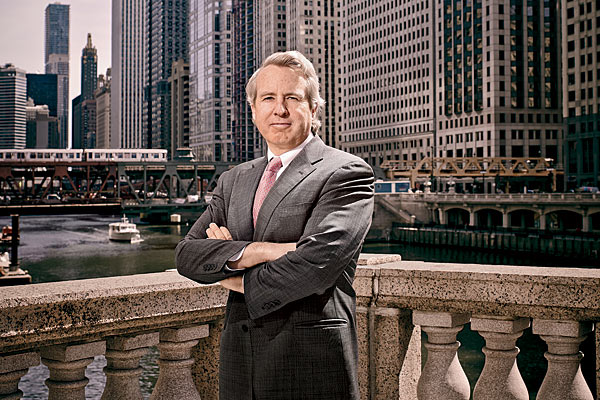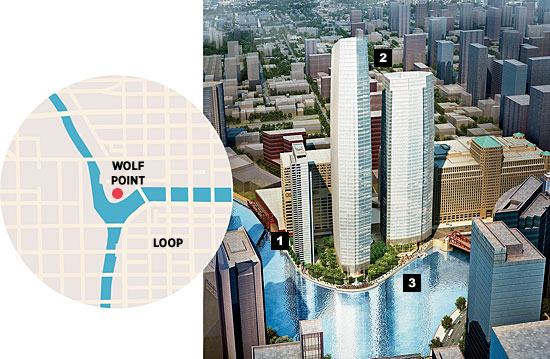Interview by Dennis Rodkin

Photo: Jeff Sciortino
Kennedy near the Wolf Point site
Your family has owned the land at Wolf Point (see below) since the 1940s. Why did you launch redevelopment plans in 2012 and not before?
We were doing other things. In the 1970s we built the Apparel Center, and in the 1980s we master-planned the Merchandise Mart and the Apparel Center, and the Kennedys put between $250 million and $350 million into renovation. That’s a lot of capital. By the early ’90s we were renovating the Merchandise Mart, and [in 1998] we sold the Mart to Vornado.
What direction did you give the project’s architects?
Water is the context in Chicago, and we’ve been driven by that. [Wolf Point is a joint venture between the Kennedy family, the AFL-CIO Investment Trust, Magellan Development, and Hines of Houston.] What does it mean to build on the river? What are the implications for building in a dense submarket with no access to natural habitat? How do we preserve the interests of the people who will work or live there? When you start with those questions, it drives the design.
They’re not simple buildings all made of glass; a sameness would start to grate on people after a while. They’re not an outrageous color or a varied shape that might be superdated after a decade. They don’t fight each other, nor do they fight other buildings, like the great KPF [Kohn Pedersen Fox] architecture that faces us [333 West Wacker Drive]. And they do a good job of masking the Apparel Center, which, incidentally, has a mostly glass façade now.
Why did the Kennedys buy the property originally?
My grandfather [Joseph Kennedy] invested in Chicago because he believed it was the crossroads of the nation. There was a stability of political leadership in Chicago: You wouldn’t have crazy outcomes. It was a mature political society capable of running competent individuals to the top.
Were you surprised by the vociferous opposition your Wolf Point development plan has faced?
No. A view is a cherished thing. We can understand why somebody with a great view would hire a lawyer. We were not surprised.
You ran the Merchandise Mart for 25 years. Why did you decide to step down in 2011?
It was after my uncle Sargent Shriver passed away [on January 18, 2011]. Sarge had had an incredible career in Chicago—he worked on the Catholic Interracial Council, for Chicago Public Schools, and other things—but none of that was mentioned in the eulogies. It was all the things he’d done since he left Chicago.
I wanted to have as full a life as I could. Am I here to renew the Steelcase lease for the seventh time? I’d always wanted to develop a not-for-profit food company around [issues of] hunger, but it was hard to do that while running the Mart.
How did hunger become an issue you decided to address philanthropically?
The Kennedys came to this country from Ireland [after] they got starved out by the potato famine. I am obviously influenced by my parents’ [Robert F. and Ethel Skakel Kennedy] commitment to public service: I moved here to start a not-for-profit around hunger back in 1987, when I married a Chicago girl, my wife, Sheila [née Berner].
Last year you and Sheila started the nonprofit Top Box Foods, which sells fresh food to churches and other groups that resell it at half of the retail price to families. What is your role?
Sheila runs the show. I go around to churches and aldermen and others and talk to them about what we’re doing and why they should be involved. And I help deliver food.
Last fall you appeared in the documentary Ethel, directed by your youngest sister, Rory. How did she convince you and your mother, who had not given an interview in 25 years, to participate?
Basically, she used the same trick on us that HBO used on her, which is, “We’re going to do it anyway.” And I have a great relationship with my mother and my younger sister, so I was happy to do it.
What do you hope people who watch it will learn?
You walk away with a hope that sometime you’ll get to meet my mother. Anybody who has seen it wants to be around her.
Your name has been repeatedly floated for governor and senator. Is there a run for public office in your near future?
No. I don’t see that right now.
* * *
What It Will Look Like
The largest real-estate development in Chicago since the bubble burst, the $1 billion Wolf Point project is finally set to break ground next month. Here’s a preview.

Rendering: Grace Van Moer
Overview: The plan calls for three towers, 2.3 acres of riverbank park land, and a river walk.
Design Features: Glass and aluminum window walls are intended to maximize the feeling of openness to the city.
1. West Tower: The first structure will be a 510-unit condo building designed by bKL Architecture. Completion: 2015
2. South and East Towers: Designed by Pelli Clarke Pelli, these buildings will contain offices, condos, and up to 450 hotel rooms.
3. River Walk: Wolff Landscape will design a 2.3-acre pedestrian park and 935 new feet of river walk.
RELATED: The Kennedys Are from Chicago, Too »


